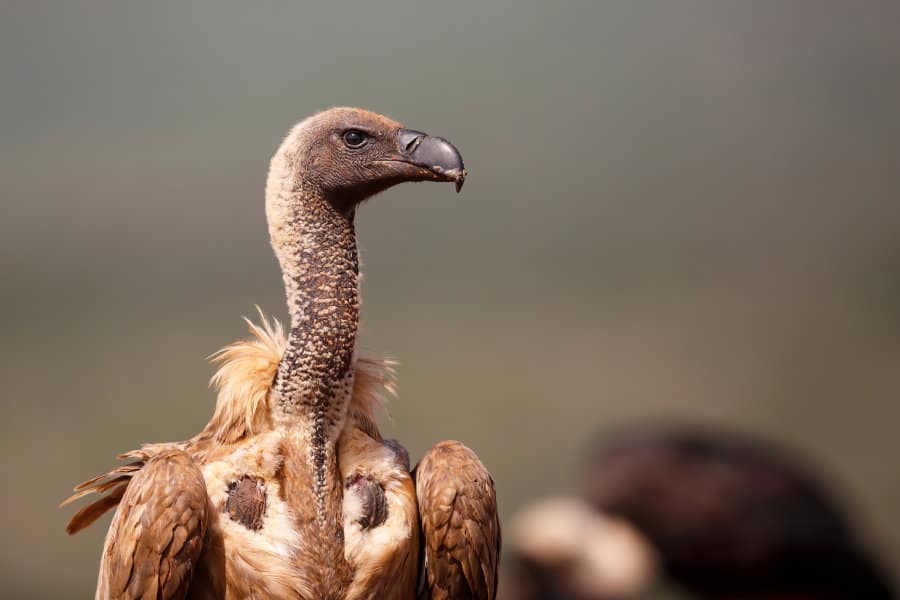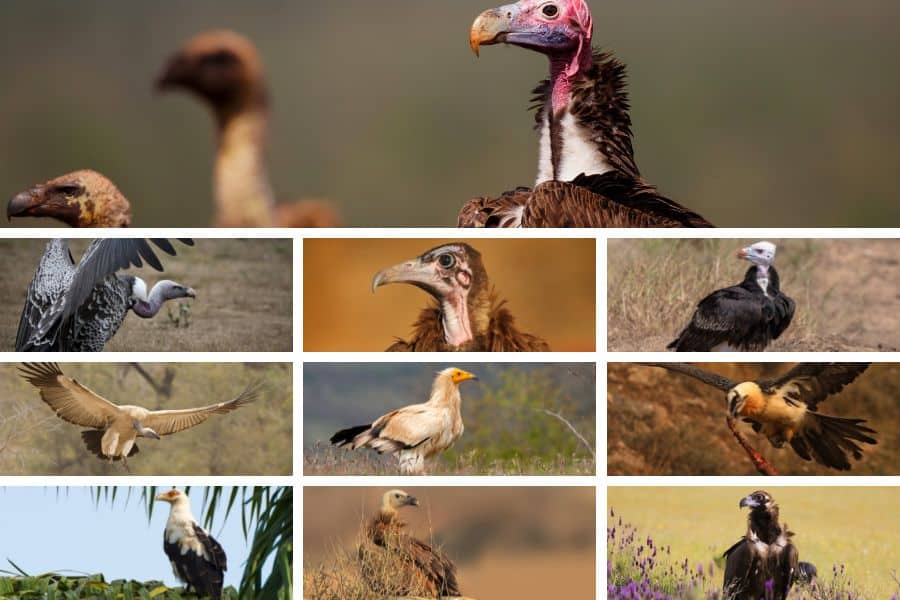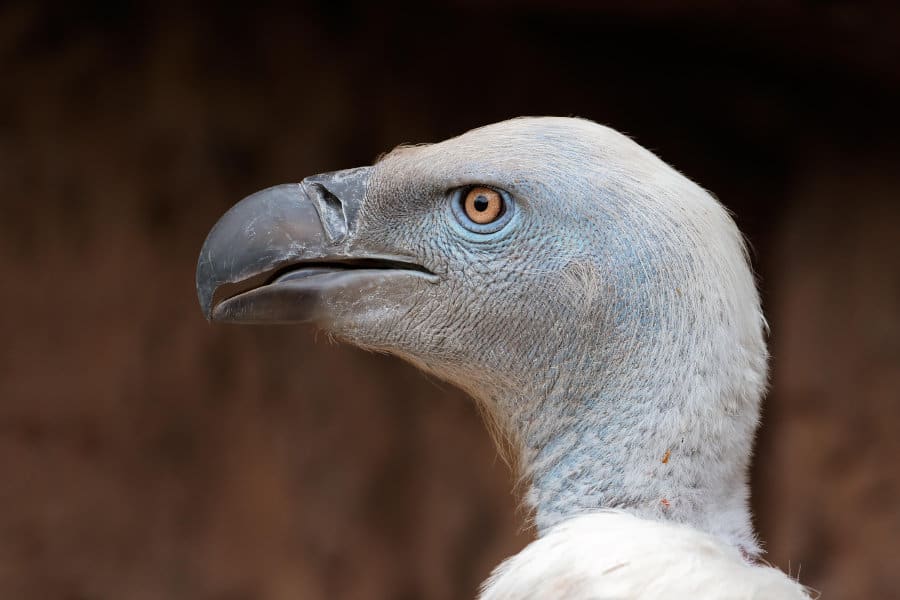The fascinating white-backed vulture once inhabited a wide range throughout sub-Saharan Africa. However, with dwindling numbers, and massive threats, these birds face a grisly future if conservation efforts prove unsuccessful.
They are vital cogs in the workings of the African ecosystem. Consuming primarily carrion, the white-backed vulture keeps the environment clean of rotting flesh, helping to reduce the spread of bacteria.
While they may be one of Africa’s ugly animals, there is more to these vultures than meets the eye. Keep reading to learn more about the habitat, diet, and population threat of these social scavengers.
What Does This African Vulture Look Like?

Much smaller than the massive lappet-faced vulture, and slightly smaller than the bearded vulture, these vultures are 94 cm tall. Their weight range is 4 kg to 7 kg with a wingspan between 1.96 m and 2.25 m.
A mature white-backed vulture has a long grey neck with soft white down and a collar of white feathers at the base of the neck. Its face is very dark, with a bald head and black beak and eyes.
The wings have white feathers on top and brown plumage underneath which gives the bird an overall gray appearance. The tail feathers are dark, and you guessed it — it has a white rump that is only visible during flight.
Juveniles are much darker overall, with dark brown wings lacking the white overtones and the white collar feathers.
African White-Backed Vulture Habitat
As its name suggests, this savanna vulture is native to Africa with the highest populations in Namibia and South Africa. Its habitat is diverse, ranging from the tropical and equatorial forests of West Africa to the open savannas of Southern Africa.
From Mauritania to Ethiopia, even inhabiting areas with an elevation of 3000 meters, the white-backed vulture’s habitat range is widespread.
However, numbers have drastically declined in the past few years. Populations have dwindled and disappeared in many countries. More on this later.
Its preferred habitat is open savanna grasslands with tall trees to nest. It’s also not uncommon to spot these vultures in human settlements, as they feed off dead livestock and are always on the search for food.
White-Backed Vulture Diet
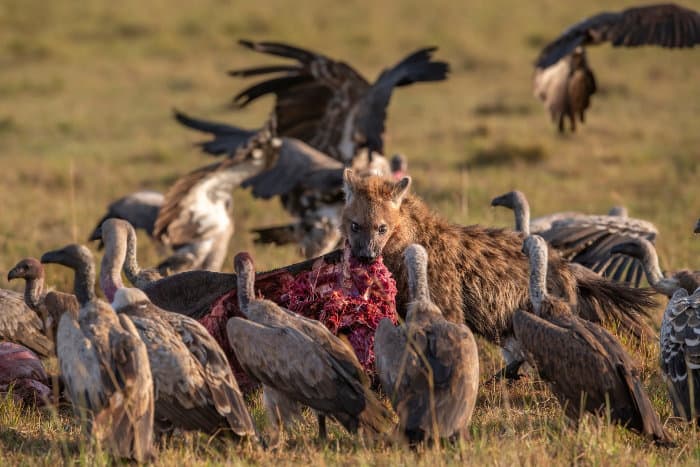
Vultures are notorious scavengers, feeding off the remains of dead animals. The white-backed vulture is no different, spending hours each day roaming the skies and scanning the ground in search of food.
Their beaks are not built for breaking through the tough skin. Therefore, they can only eat soft-tissue animals such as wildebeest and zebra — luckily, much-loved meal options of African apex predators.
Carrion may let off a nasty stench, but a vulture’s sense of smell is quite terrible, a common trait of Old World vultures. They rely on their good eyesight and the presence of other scavengers to find food.
If the vulture spots other scavengers, such as jackals and hyenas, or other vultures, there’s a good chance that there’s a meal waiting to be had and the bird will go investigate.
Once the vulture locates a tasty carcass, it will wheel in the sky to notify other vultures. However, even with dead prey, there is a hierarchy. Oftentimes the vultures need to hang out in trees nearby, watching as the bigger and stronger scavengers have their fill first.
The white-backed vultures are gluttonous and aggressive eaters. They often take a hostile stance, pushing other animals away from the carcass. Then they will feast on the carrion, sometimes eating so much that they are unable to fly.
These long-necked vultures feed themselves primarily through scavenging. However, when the carrion is sparse they may eventually hunt. Their prey of choice includes juvenile springbok, red-billed quelea chicks, and baby warthogs.
Breeding and Behavior of the Gyps africanus
Gyps africanus, the scientific name for white-backed vultures, are very sociable birds, often gathering in huge groups to feast on remains. They are not very vocal but do emit some pig-like noises, squealing and chittering, when they find a good chunk of a dead animal.
Sticking to their social feeding nature, this vulture breed is a colonial nester. They roost in trees very close to other vultures.
They construct a simple roosting platform using sticks and branches. The platform is then covered with dry grass, and sometimes a sprinkle of green leaves. Usually, these nests are in trees such as the vultures’ much-loved acacia.
Sometimes you’ll see a nest on electricity pylons or other man-made structures.
White-backed vultures are monogamous and only breed once per year, with the female laying just one egg. This poses even more challenges to conservation.
The female and male share parental duties, from incubation to feeding the fledgling. The chick hatches in approximately sixty days and by four months old it is independent enough to leave the nest. However, it will stay in the care of its parents for several months more before flying the roost.
African White-Backed Vulture Population Threats

This vulture, unfortunately, is critically endangered. While the usual suspects such as habitat loss and poaching for meat and traditional medicine is a problem, the biggest threat to the population is poisoning.
Poisoning has wiped out an astounding number of white-backed vultures. There are a few different sources of poison.
Indirect poisoning occurs when these vultures feed on livestock. They risk consuming an anti-inflammatory drug given to the livestock which is fatal for the vultures.
However, deliberate poisoning is becoming much more of a problem. Farmers use pesticides called carbofuran (sold as Furadan) to poison predators, such as big cats, that attack livestock. The pesticide is often sprinkled over a dead farm animal, which in turn kills anything that eats it.
Poachers also use pesticides on poached animals to kill the vultures so that they don’t attract attention. When vultures circle in the sky above a poached rhino or elephant, it alerts rangers on the lookout.
Both white-backed vultures and hooded vultures face extinction due to this onslaught of poisoning.
White-Backed African Vulture Facts
Check out some interesting facts about this Old World vulture.
- Although the neck of the white-backed vulture looks bald, it has a fine down covering. Its head, on the other hand, is bald which helps to regulate its body temperature and helps to keep the vulture clean when it is neck-deep in a carcass.
- This African vulture species plays an important role in the ecosystem. As scavengers, they act as the clean-up crew of the wild. If animal flesh rots, it becomes a breeding ground for bacteria and viruses. By eating carrion, the vultures help to reduce the risk of this happening.
- It’s not unusual for up to 100 white-backed vultures to feed off a single animal. With these numbers, the vultures can strip clean a 45 kg carcass in approximately three minutes.
- These vultures cover massive distances in search of food. It’s common for juveniles to migrate as far as 1500 km from their hatch territory.
- African white-backed vultures are Old World vultures. These are vultures that inhabit the ‘old world’ which includes Asia, Europe, and Africa.
- A fine layer of skin covers the vulture’s ears, hiding them from sight. This is to protect the ear from food debris while eating.
- Despite its unseemly eating habits, this vulture is very concerned about personal hygiene. They spend a lot of time bathing and cleaning themselves at waterholes.
- Feeding on dead animals might seem like risky business. However, the high acidity levels of the vulture’s stomach acids neutralize any pathogens. So, the vulture cannot get a bad case of food poisoning nor will it spread diseases to other animals.
- The closest bird relation that the white-backed vulture has is a stork.
- The collective noun for a group of vultures is a ‘committee’, ‘venue’, or ‘volt’. And with a relatively dark spin, a ‘wake’ is the name for a group of feeding vultures.
- Vultures cool down their body temperatures by urinating on their legs and feet. This has the added benefit of killing parasites.
- While they are aggressive eaters, white-backed vultures will stand down if larger vultures swoop down to eat. Sometimes, the subordination results in the white-backed vulture getting stuck inside the carcass and eaten.
Look Out for Circling White-Backed Vultures
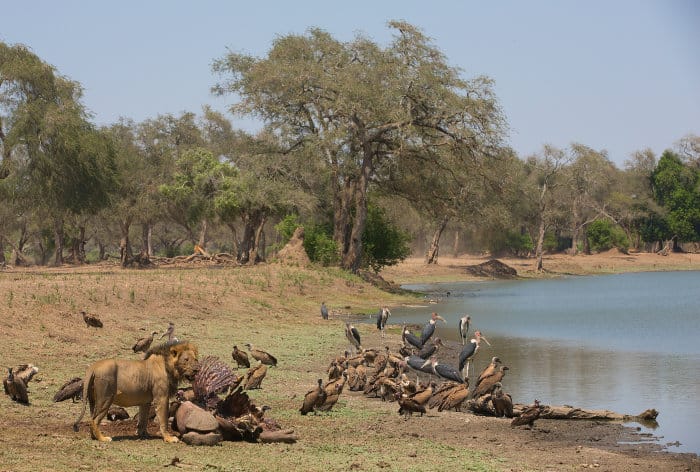
Despite their less-than-appealing looks, white-backed vultures are an integral part of a healthy African ecosystem and possess fascinating social behaviors.
As it stands, your best chance of spotting one of these amazing vultures is on the plains of Namibia or South Africa. Head out on safari and try to spot a group of circling vultures hungrily scoping out a carcass. You may even witness a ‘wake’.
With declining populations, don’t wait too long to book a safari and see these scavengers in action.
